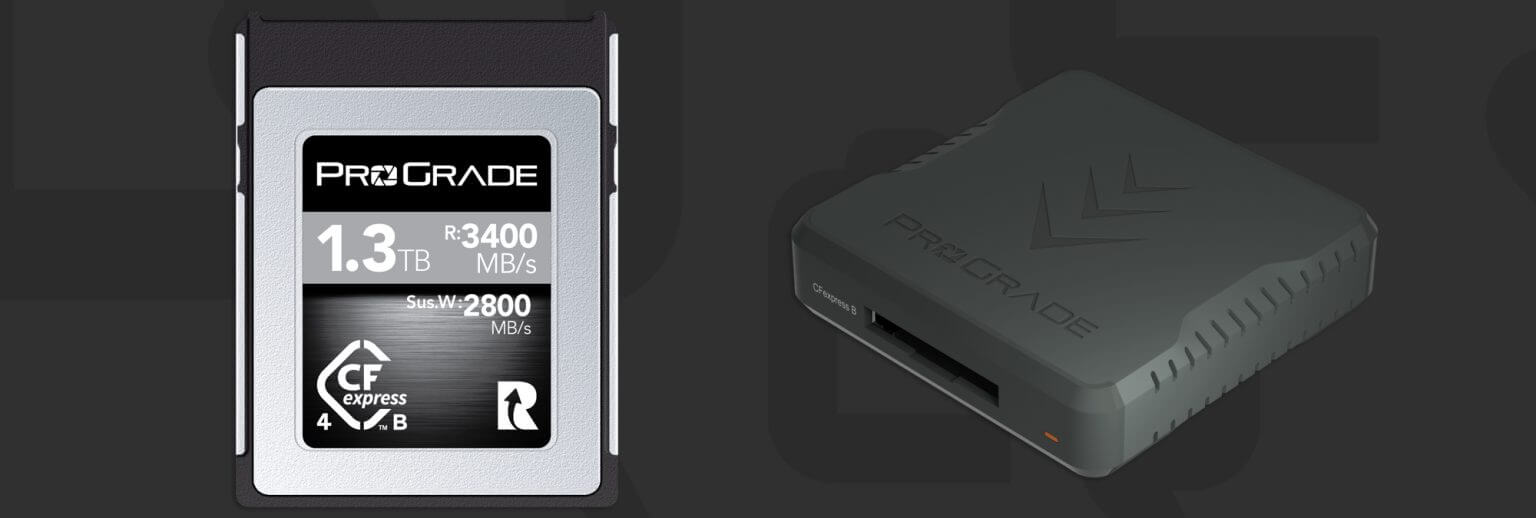San Jose, CA September 5, 2023, 8:00 am ET — ProGrade Digital, Inc., founded with a mission to provide the highest quality professional grade digital memory cards and workflow solutions, announces the 3rd generation of its CFexpress™ Type B Cobalt-class memory card in a new 1.3TB capacity. This new generation features the same industry-leading quality of ProGrade current 2nd generation 325GB and 650GB capacity cards, but now leverages PCIe Gen 4 interconnect with NVMe 1.4c host controller interface. ProGrade Digital’s 3rd generation CFexpress Cobalt cards are fully compliant with the just released CFexpress 4.0 specification, and provide read speeds of up to 3,400MB/s, burst write speeds of up to 3,000MB/s, and sustained write speeds of up to 2,800MB/s – ideally suited for the highest-resolution cinema-grade video capture applications. As in past Cobalt-class memory card generations, the highest endurance and reliability memory technology is utilized – ensuring years of trouble-free, high-performance capture.
“The introduction of our 3rd generation CFexpress Cobalt card at the 1.3TB capacity point provides the extra space and unparalleled performance needed for the very highest resolution video capture needs,” said Wes Brewer, Founder and CEO of ProGrade Digital. “Our inclusion of PCIe Gen 4 controller technology, coupled with upcoming USB 4.0 high-speed readers will allow offloading speeds 3x greater than previously possible, providing a dramatic reduction in workflow processing time.”
ProGrade Digital CFexpress Type B 1.3TB Cobalt Memory Card:
- Maximum read speed up to 3,400MB/s
- Burst write speed up to 3,000MB/s
- Minimum sustained write speed up to 2,800MB/s
- CFexpress 4.0
- Capacity: 1.3TB
- MSRP: $1,459.99
CFexpress Type B 1.3TB Cobalt Delivers:
- Fully compliant with CompactFlash™ Association 4.0 specification and backward compatible with 2.0 specification
- NVMe host interface with PCIe Gen4 X2 interconnect
- Low standby power through NVMe PS0 – PS4 support enabling extended battery life
- Metal enclosure for improved durability and heat dissipation
- Thermal throttling protects the card from overheating
- Laser etched unique serial numbering for the tracking of key components and manufacturing data for the highest quality control
- Temperature ranges: operating 14°F to 158°F/ -10°C to 70°C; storage -4°F to 185°F/ -20°C to 85°C
- Packaging: Biodegradable fiber tray
- Refresh Pro ready*
- SLC (Single Level Cell) memory technology for the highest endurance and reliability
- RED V-Raptor and Komodo X approved
- X-ray proof and shock-proof
- 3-year warranty
ProGrade Digital USB 4.0 CFexpress Type B Single-Slot Card Reader Key Features:
- Single-slot memory card reader for CFexpress 4.0 Type B cards
- Backward compatible with CFexpress 2.0 Type B cards
- Transfer rates of up to 40Gbps (5GBytes/sec)
- USB 4.0 interface
- Patented magnetic base and included adhesive metal plate
- Heat sink for extra cooling capability
- Refresh Pro™ enabled*
- USB 4.0 certified cable included
- MSRP $99.99
ProGrade Digital products are available at B&H Photo and Amazon.


I know Asmedia introduced an PCIe4 to TB4/USB4 controller recently, that would allow us to have those 3gbyte/s read speeds for getting the photos and videos onto our computers.
However, the buffer would be much improved on your R5.
Your R3 would benefit the most since it can go up to 195 FPS.
The current buffer is only 1/2 second for 50 FPS and above.
In regards to your computer, if it does not have USB 4 or the ability to install an internal drive then you might not see much of a difference.
And the big question is how hot will those new cards run? And perhaps they will run cooler at current gent speeds in eg a Canon R5?
My PC actually has two Thunderbolt4/usb4 40Gbps ports. And since my current wise card reader (G1) is a bit unstable I might buy the new card reader, in order to be a little futureproof and also get slightly better offloading speeds on my current cards.
I don't know what the R5 peaks out at, but I doubt it would be quicker than the R3.
So we can get a 3-4x improvement with the ‘old’ PCIe3 cards in future bodies if Canon decides to use full speed CFe :)
VPG400:
CFexpress Cards Explained
It would be pointless to have a faster CF Express standard without also having an increase in the standard for sustained write speeds as well.
I am assuming that there will be a corresponding VPG 800.
I don't see Canon upgrading existing cameras via firmware but I am hoping for that with the R1, R5 II, and R3 II.
And don't tell people what the 'V' in VPG stands for, they might faint after realizing that a body without any video related feature will have severely hampered still capabilities ;)